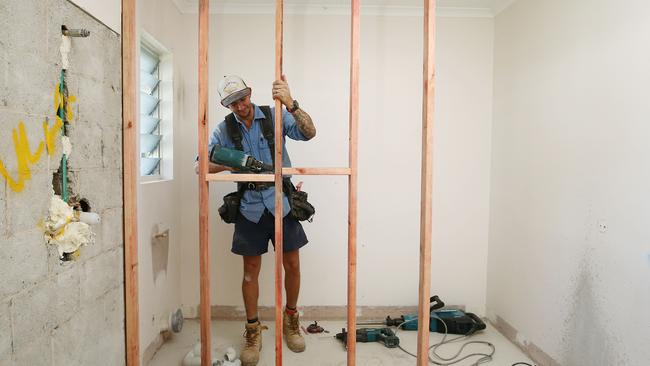Cairns real estate: Development costs rise as council hunts revenue
Ratepayers and developers have been slapped with a price rise triple whammy as Cairns Regional Council drives up costs to help offset mounting debts – but should we just cop it?
Cairns
Don't miss out on the headlines from Cairns. Followed categories will be added to My News.
RATEPAYERS and developers have been slapped with a price rise triple whammy as Cairns Regional Council drives up costs to help offset mounting debts.
Building industry leaders are quietly seething over a council decision to do away with discounted development fees that had been in place for more than a decade.
One industry source said developers were likely to be slugged with about $6000 more in charges per subdivision block – although in-fill developments like backyard subdivisions would still attract discounts.
Multiple policy amendments have also been pushed through that more than double the cost for impact-assessable projects which require a public consultation process.

The development fee hike comes alongside a general 2.5 per cent residential rate rise – higher than CPI – and household water usage charges jumping 16.3 per cent from $1.20 to $1.43 per kilolitre.
Urban Development Institute of Australia’s (UDIA) new Cairns branch co-chairman Nathan Lee Long questioned the timing of the spike in fees.
“Our fear is that it will have an impact on housing affordability, because ultimately those charges are passed on to the purchaser,” he said.
“It’s purely just a revenue stream for council, and at the end of the day the ratepayer is the one footing the bill.”
The price hike coincides with industry criticism of an increasingly slow development assessment process – something the council has acknowledged by announcing it needed to hire temporary staff to deal with the workload.

Several of the planning department’s top employees have quit in recent months, and those remaining or replacing them are struggling to keep up with demand.
“In a time where the development industry is a large part of the backbone of the city’s economy, and a time when costs are going up because of demand, the question is whether this is the right time to do it,” Mr Lee Long said.
The shift came from the council opting to charge the full development fee cap set by the State Government instead of its historically discounted rate.
Cairns building industry veteran Pat Flanagan said the UDIA should think hard before being too critical of the local government.
“The council could have charged that cap charge since about 2007,” he said.
“The cap charge is a direct consequence of the UDIA lobbying to the Newman government which brought in cap charges in Brisbane.

“But the state applied the cap charge across the whole state which killed a lot of development in the regions, simply because of the UDIA’s persistence about Brisbane.
“The development industry in Cairns has done very well for itself over the past 10 or 15 years.
“They’ve been paying a lot less than they could have.”
The council’s planning and environment interim general manager Martin Garred explained infrastructure fees were essential to cover costs to ratepayers such as providing roads, sewer networks and water treatment resulting from new residential development.

“Council’s infrastructure fees have historically been considerably lower than other regions, and well below the amount allowed under state legislation,” he said.
“When setting the 2021-22 budget, council chose to increase infrastructure fees payable by developers, resulting in a lower rate increase on residents.
“The 21.7 per cent increase in fees payable by developers of residential dwellings, puts Cairns at the same level of similar sized cities in the state, including Townsville, Mackay, the Gold Coast and Brisbane.”
Mr Garred said infrastructure fees for two and three-bedroom apartments were not increased and incentives remained in place for in-fill development since the need for more high-density housing had been identified.

The new fees are here to stay with the council projected to take out $293m in new long-term loans from this financial year to 2026-27 on top of $123m borrowed over the previous budget cycles.
“Infrastructure fees are only one component of the cost of building,” Mr Garred said.
“Ultimately the market will determine the demand for future housing development in the city.”
LOBBY GROUP’S NEW LEADERS
THE Urban Development Institute of Australia has appointed two new leaders to its Cairns branch after former chairman Ranjit Singh’s resignation.
The Urban Development Institute of Australia (UDIA) issued a statement last month saying Mr Singh had resigned as Cairns branch president “following media reporting of an alleged business loan” to Mayor Bob Manning.


“Mr Singh’s offer to stand down, and the institute’s acceptance of it, should not be taken as an indication of any wrongdoing on his part,” the statement continued.
The position has now been split in two with Jacobs Group associate Nathan Lee Long and NAB business banking executive Elisha-Vi Raso sharing the top job.
UDIA chief Kirsty Chessher-Brown said the pair brought an outstanding record of contribution to the industry and the Cairns community at large.
She said the UDIA’s greatest strength was its backbone of senior experts who volunteered their time to help support an industry that supported close to 7000 jobs in the region and contributes $1.9b to the local economy annually.
“Both Nathan and Elisha-Vi have an incredible depth of expertise and experience they will bring to this role,” Ms Chessher-Brown said.
More Coverage
Originally published as Cairns real estate: Development costs rise as council hunts revenue




